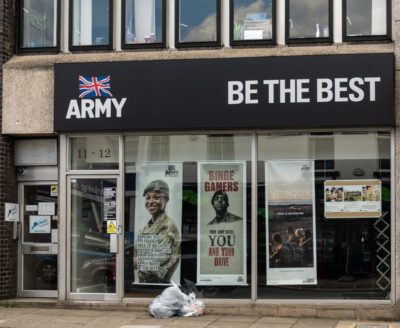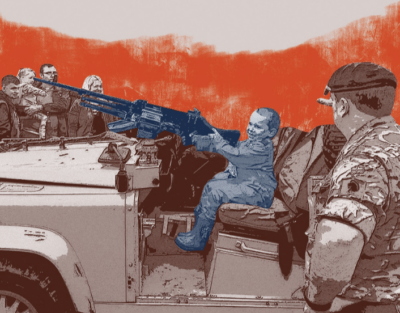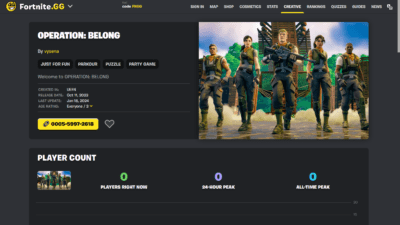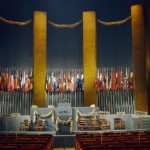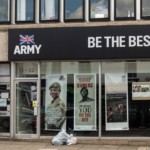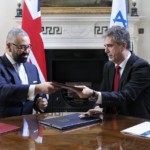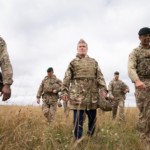5 Soldiers: The Body is the Frontline.
Lauren Bryden & Poppy Kohner, from Resist Militarism
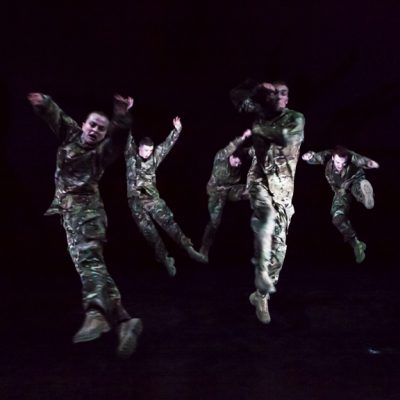
Lauren Bryden & Poppy Kohner explore the implications of Rosie Kay’s production of 5 Soldiers: The Body Is The Frontline, a dance piece exploring the ‘physicality’ of war and its effect on soldiers’ bodies.
While captivating and enlightening, does placing the body at the centre of the narrative of war obscure political comment on what these bodies do and, crucially, why they do it? The support of the production by the British Army and their presence at the event raises important questions about the role of the military in public arts spaces.
On the evening of Friday 29 April in Tramway 1 – one of the most impressive, and experimental, theatre spaces in Scotland – we found ourselves captivated by Rosie Kay’s production of 5 Soldiers: The Body Is The Frontline; a show that, in Scotland, is supported, part-funded and produced in association with the British Army.
Kay’s 5 Soldiers is not an anti-war dance piece, nor is it intended to be. Instead, Kay’s focus for the performance is the ‘physicality’ of war, and offers a parallel between dancers’ and soldiers’ bodies, inspired by Kay’s personal experience of long-term injury and the arduous regime demanded of a professional dance career. As Kay and Brigadier Gary Deakin, Command Head of the British Army in Scotland, reminded the audience before the performance at a wine reception, “Soldiers and dancers both must have courage, discipline, physical fitness and loyalty; both must train in competitive environments; both risk serious injury”.
The defining question of the evening emerged therefore: when did the performance begin, and when did it end?
Did it begin when guests were greeted outside the Tramway by the sight and sound of a military pipe band? Or when programmes were distributed from soldiers in uniform instead of Tramway staff? Was it at when Brigadier Deakin gave a rousing speech before the show? Or, did the performance begin when Rosie Kay was embedded in the 4th Battalion the Rifles for two weeks to research the piece?
To some extent, the performance itself provided a breathing space from all of this. The physical parallels between solider and dancer were expressed deftly and the five dancers did not just capture the bodily techniques involved in soldiering, but enhanced them, proving themselves to the audience, many of whom were military members. The stage was stripped back aside from 8 tyres used shrewdly as props throughout the performance. Dancers performed military drills in double-time around the bare stage, exhausting themselves before the show had even begun, and sweat flew off their bodies as they took on multiple roles in scene-after-scene, making for a visceral and varied performance. The piece ambitiously tried to deal with multiple struggles and strains involved in the experience of being a soldier: the removal of identity, belonging, women in the military, sexual abuse, masculine vulnerability, sacrifice, and injury.
A projected painted mountain scene – conjuring up a fantastical, imagined, version of Afghanistan – was the backdrop to a gracefully choreographed parachute jump, which was immediately followed by an action-packed scene of the unit on deployment. A bomb detonates, leaving one solider badly injured. The dancer momentarily lifts his arms in a Christ-like pose to Pergolesi’s Stabat Mater, before his top half is stripped naked and his legs strapped behind him, as if they have been amputated below the knee. The chaotic action of the five bodies on stage is juxtaposed with a haunting image of him, alone, attempting to march as the lights slowly fade out.
But while the dance was done, the performance was not. A post-show panel of 9 speakers, including two representatives of the British Army, took to the stage. During this discussion one dancer spoke of their time embedded in the military as, “one of the best times of my life”, while another offered, “it has completely changed my perception of the military”, which elicited a clap from the audience. Kay and Brigadier Deakin continued the performance in a choreographed duet that would have made the army recruitment public relations team proud.
Kay claims the piece is ‘not overtly political’, while uncritically placing the military centre-stage as an object of empathy, and even desire.
Were the dancers aware that while they believed to be performing the reality of soldiers’ lives on stage they were also ‘dancing for Britain’? Were they aware that in trying to critically engage with the uncomfortable areas of injury and disability, they were also promoting the armed forces as a profession? As they danced, their own bodies adorned in camo, they were part of the mystification process of reinforcing militarism, and, while doing so, erasing a critique of the armed forces in society.
Kay’s production places the body at the centre of the narrative of war; bodies which injure and are injured. But – like the many military charities who mask the politics of war with nationalist notions of honour – the elevation of the body as the site of critical engagement of war obscures political comment on what these bodies do and, crucially, why they do it.
The performance raises uncomfortable questions about the role of the military in public arts spaces and whether there is a need or responsibility for a body of contemporary artists to represent, and critique, war. Kay claims there is no cannon in which she can place the work, and that too few artists are representing contemporary warfare.
Yes, this performance was captivating. But it was only on quiet reflection that we really began to appreciate why 5 Soldiers is so unsettling. And what remained was a prevailing, troubling feeling that we had been drawn in to empathise with the military as an institution which claims to ‘care and protect’, and not with the working class soldiers’ reality that this performance purports to depict.
Far from the military supporting the arts, 5 Soldiers at The Tramway is a worrying example of how the arts in Scotland are supporting, and accommodating, the military.
See more: recruitment, risks, veterans, culture
Like what you read?
> Sign up for our newsletter or blog notifications
> Support our work – from just £2 a month

